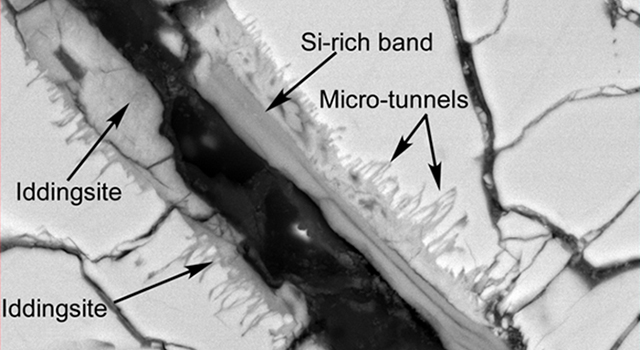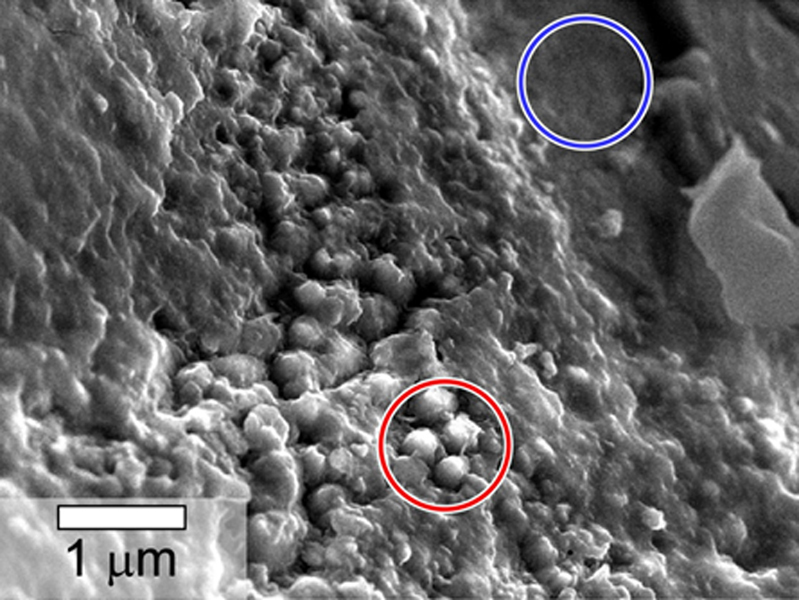Evidence of former life on Mars?
March 4, 2014

This scanning electron microscope image of a polished thin section of a meteorite from Mars shows tunnels and curved microtunnels (credit: NASA)
A team of scientists at NASA’s Johnson Space Center and the Jet Propulsion Laboratory has found evidence of past water movement throughout a Martian meteorite, reviving debate in the scientific community over life on Mars.
The team reports that newly discovered structures and compositional features within the a 30-pound (13.7-kilogram) Yamato meteorite suggest biological processes might have been at work on Mars hundreds of millions of years ago.
Analyses found that the rock was formed about 1.3 billion years ago from a lava flow on Mars. Around 12 million years ago, an impact occurred on Mars that ejected the meteorite from the surface of Mars. The meteorite traveled through space until it fell in Antarctica about 50,000 years ago.
Distinctive biogenic features

Spheroidal Features in Yamato Meteorite From Mars. This scanning electron microscope image shows spheroidal features embedded in a layer of iddingsite, a mineral formed by action of water, in a meteorite that came from Mars. An area with the spheres, circled in red, was found to have about twice as much carbon present as an area (circled in blue) without the spheres. This meteorite, named Yamato 000593, was found in Antarctica in 2000 and identified as originating from Mars. The scale bar at lower left is 1 micron. (Credit: NASA)
The team found two distinctive sets of features associated with Martian-derived clay. They found tunnel and micro-tunnel structures that thread their way throughout Yamato 000593. The observed micro-tunnels display curved, undulating shapes consistent with bio-alteration textures observed in terrestrial basaltic glasses, previously reported by researchers who study interactions of bacteria with basaltic materials on Earth.
The second set of features consists of nanometer- to-micrometer-sized spherules that are sandwiched between layers within the rock and are distinct from carbonate and the underlying silicate layer. Similar spherical features have been previously seen in the Martian meteorite Nakhla that fell in 1911 in Egypt. Composition measurements of the Y000593 spherules show that they are significantly enriched in carbon compared to the nearby surrounding iddingsite layers.
A striking observation is that these two sets of features in Y000593, recovered from Antarctica after about 50,000 years residence time, are similar to features found in Nakhla, an observed fall collected shortly after landing.
The authors note that they cannot exclude the possibility that the carbon-rich regions in both sets of features may be the product of abiotic (non-life) mechanisms: however, textural and compositional similarities to features in terrestrial samples, which have been interpreted as biogenic, imply the intriguing possibility that the Martian features were formed by biotic activity.
“This is no smoking gun,” said JPL’s White. “We can never eliminate the possibility of contamination in any meteorite. But these features are nonetheless interesting and show that further studies of these meteorites should continue.”
In 1996, a group of scientists at Johnson led by David McKay, Gibson, and Kathie Thomas-Keprta published an article in Science announcing the discovery of biogenic evidence in the Allan Hills 84001(ALH84001) meteorite.
The team’s new findings have been published in the February issue of the journal Astrobiology. The lead author, Lauren White, is based at the Jet Propulsion Laboratory. Co-authors are Gibson, Thomas-Keprta, Simon Clemett and McKay, all based at Johnson. McKay, who led the team that studied the ALH84001 meteorite, died a year ago.
Abstract of Astrobiology paper
We report the first observation of indigenous carbonaceous matter in the martian meteorite Yamato 000593. The carbonaceous phases are heterogeneously distributed within secondary iddingsite alteration veins and present in a range of morphologies including areas composed of carbon-rich spheroidal assemblages encased in multiple layers of iddingsite. We also observed microtubular features emanating from iddingsite veins penetrating into the host olivine comparable in shape to those interpreted to have formed by bioerosion in terrestrial basalts.
Abstract of Science paper
Fresh fracture surfaces of the martian meteorite ALH84001 contain abundant polycyclic aromatic hydrocarbons (PAHs). These fresh fracture surfaces also display carbonate globules. Contamination studies suggest that the PAHs are indigenous to the meteorite. High-resolution scanning and transmission electron microscopy study of surface textures and internal structures of selected carbonate globules show that the globules contain fine-grained, secondary phases of single-domain magnetite and iron sulfides. The carbonate globules are similar in texture and size to some terrestrial bacterially induced carbonate precipitates. Although inorganic formation is possible, formation of the globules by biogenic processes could explain many of the observed features, including the PAHs. The PAHs, the carbonate globules, and their associated secondary mineral phases and textures could thus be fossil remains of a past martian biota.